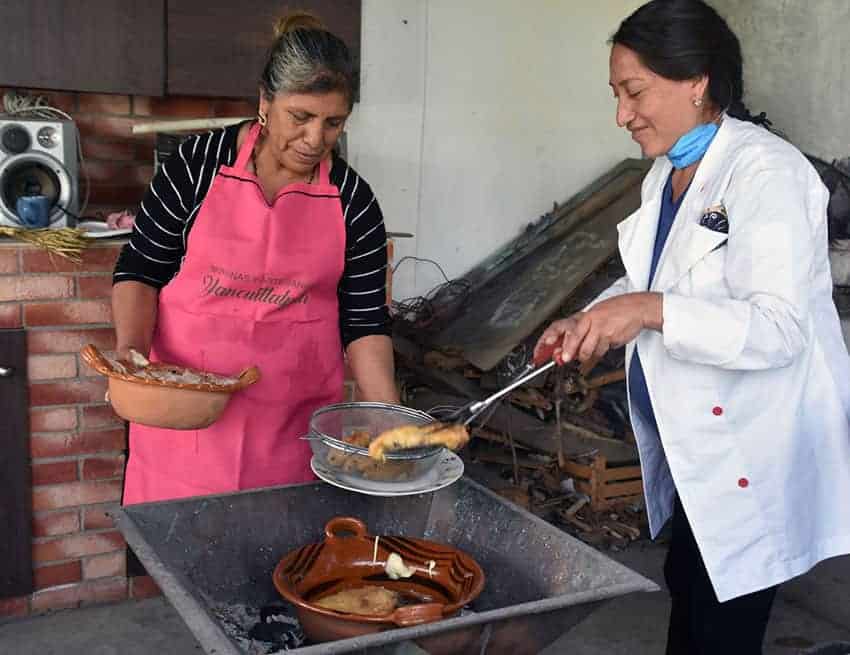Chile navideño, unlike many traditional Mexican dishes, doesn’t appear to have an origin story. There’s no legend about a nun whipping up the first batch of mole while under the spell of a celestial inspiration, or a story about how it may have been invented, like chile en nogada, to celebrate Mexican independence.
But that doesn’t seem to bother anyone. The dish, which is a staple in Puebla during the Christmas season, is enjoyed despite its lack of a clear, or colorful, backstory.
Luís Heric Ponce Rivera makes the stuffed chiles for his family every December. “I learned from my mother, who learned from her mother,” he said. “It is a family recipe. It goes back generations.” Making the chiles, while not arduous, is definitely time-consuming.
Dried chipotles, which are a type of jalapeño, are used to make the dish. “Do not use fresh,” said Ponce. “Always start with dry [chiles]. “One can use fresh jalapeños or poblanos for stuffing but for chile navideño, always start with dry. It has a different flavor.”
He first soaks the chiles in salted water for about half an hour, then slices them and removes the seeds and veins. “This is very important,” Ponce explained, “or the chiles will be too spicy.” After another two or three hours in salt water, he boils “some” piloncillo and adds that to the chiles, along with a teaspoon each of sugar, salt, thyme, oregano and some bay leaf. The chiles are then left to soak overnight.

“This is to get the flavor of the herbs and piloncillo,” he continued. “This gives the chile a sweet flavor.” Like many family recipes, getting exact measurements from people is a bit of a challenge, but the above measurements should be within the ballpark.
Every pueblo and, really, every family has its own recipe for traditional dishes and chile navideño is no exception. I’d visited Concepción Fernández in San Pedro Yancuiltlapan a couple of months back to write about her chiles en nogada and decided a return trip was necessary for this article. I was curious to see what differences there were between the two recipes. Besides, her chiles en nogada were excellent, warranting a return trip for a chance to sample another dish. It was worth the trip.
As expected, there were some differences between the two recipes; most were minor but there was one unexpected difference.
Like Ponce, Fernández soaks her dried chiles in salted water, but only for a short time and until they’re soft, and doesn’t add any other spices. And while Ponce uses a stove, Fernández insists on using clay pots and charcoal in all her cooking. “The clay and charcoal give the chiles their flavor,” she said.
Hers is also a family recipe. “I learned from my niece,” she said. “My parents did not have the money to buy the chiles. They are very, very expensive.” Large, dried chipotle navideño currently cost 360 pesos/kilo (about US $8/lb) while smaller ones run about 120 pesos/kilo ($2.70/lb).
After removing the veins and seeds, both she and Ponce stuff the chiles with panela or queso fresco, which are mild cheeses. Then they both coat the chiles with flour, dip them in beaten eggs and fry them to a crispy, golden brown. So the two recipes are very similar.

But there was one surprising difference: Fernández stuffs a few of hers with chapulines. Roasted grasshoppers. “That is only found in this pueblo,” said Guadalupe, her helper and daughter-in-law. “It is something original.”
Ponce serves his chile navideño as a torta — a sandwich — while Fernández serves hers with sliced bread on the side. The bread is torn into smaller pieces and used to pick up bits of the chile. Ayocote, a large bean, is a typical side dish. Serving the chiles topped with a tasty salsa roja or verde also works well.
Chile navideño has a deliciously smoky flavor. Ponce’s version is a little milder and sweeter than Fernández’s but both are wonderful. I begged off tasting the chiles she’d stuffed with chapulines, so I can’t say what they tasted like but her husband said they were particularly tasty.
“In homes, chiles navideños are only made during December,” said Ponce, “but they are available all year in stores. We always have them on Christmas and New Year’s Day.” Fernández serves them on Christmas Eve and New Year’s Day and said that in San Pedro Yancuiltlapan they’re available until February 14.
But there are some people who simply can’t wait for the traditional season. “Sometimes for a birthday, someone will say, ‘I would like chiles navideños and fish.’ We use a fish called bandera, which is cheap, because here, there is not much money.”
Joseph Sorrentino is a regular contributor to Mexico News Daily.
